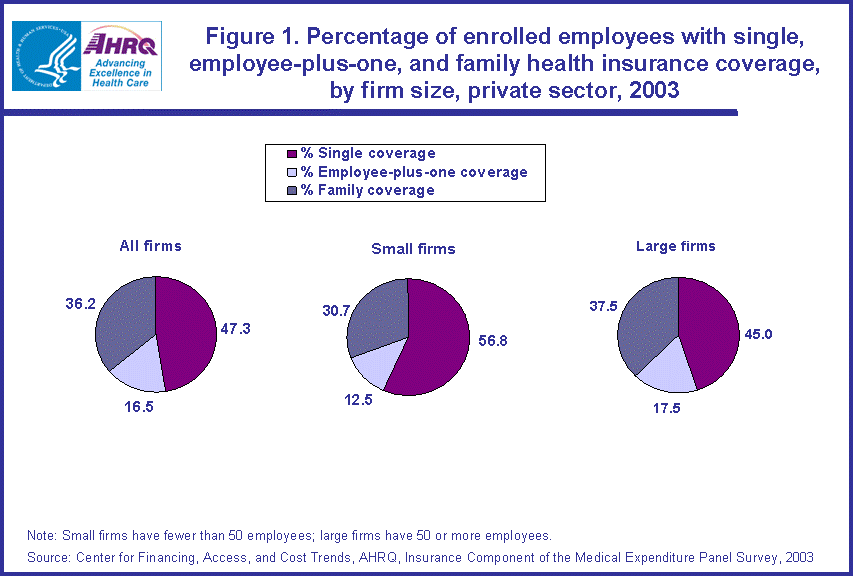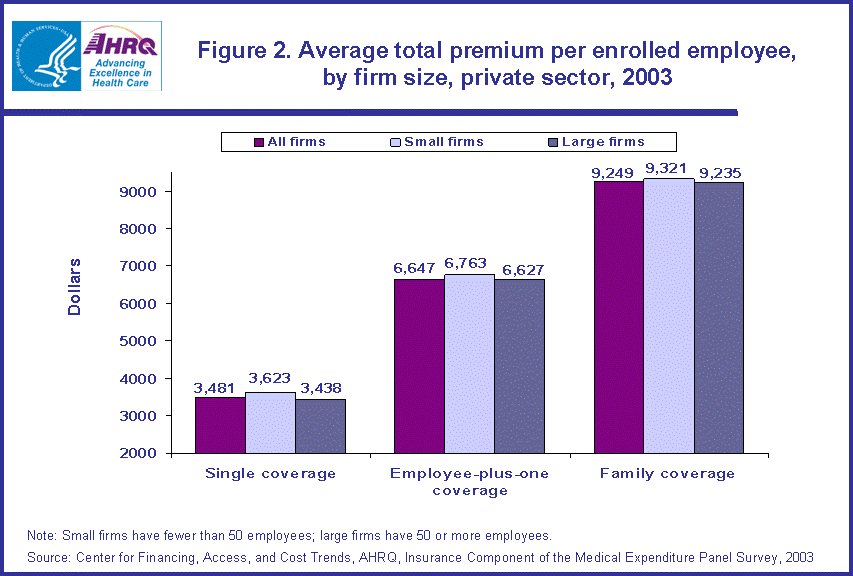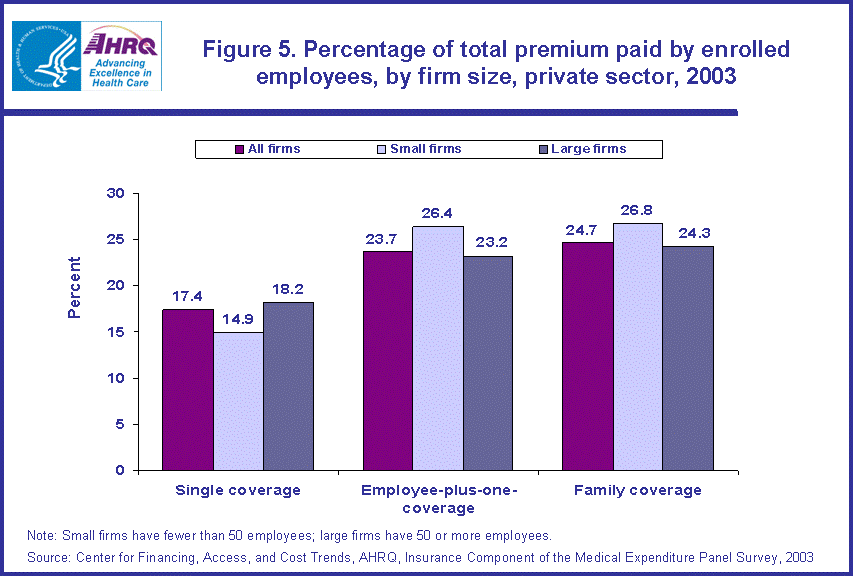
|
|
Font Size:
|
||||
|
|
|
|
||||
STATISTICAL BRIEF #90:
Employer-Sponsored Single, Employee-Plus-One, and Family Health Insurance Coverage: Selection and Cost, 2003
Highlights
- In 2003, the average annual family coverage premiums ($9,249) were much higher than those for employee-plus-one coverage ($6,647), which in turn were much higher than single coverage premiums ($3,481). Compared to those with single coverage, employees with non-single coverage also contributed a larger amount toward their premium both in terms of dollars and percentage of total premium cost.
- Premiums in 2003 increased by 9.2 percent for single coverage, 10.0 percent for employee-plus-one coverage, and 9.2 percent for family coverage over the prior year (2002), continuing a trend of increasing premiums observed each year since the start of the survey in 1996.
- In 2003, 47.3 percent of private sector employees with health insurance through their employer were enrolled in single coverage plans versus 52.7 percent who were enrolled in non-single coverage plans. About one-third of employees with non-single coverage were in employee-plus-one plans.
- For both large and small employers, employees with single coverage were much more likely to not have to contribute toward their plan's premium than employees with non-single coverage. Overall, 27.3 percent of those enrolled in single plans did not contribute toward the premium cost compared to 14.2 percent of those with family coverage and 9.6 percent of those with employee-plus-one coverage.
Introduction
Health insurance provided by employers is a key source of coverage for both employees and their families. In 2003, more private sector employees obtained non-single coverage health insurance (a plan covering the employee and at least one other family member) through their employers than single, self-only coverage. According to the Insurance Component of the Medical Expenditure Panel Survey (MEPS-IC), those employees with non-single coverage contributed both a larger dollar amount and a larger percentage of the total premium for their coverage than did employees with single coverage.
Non-single health insurance plans encompass two types of coverage: family coverage and employee-plus-one coverage. Prior to 2001, MEPS-IC only collected information on family coverage plans. Information relating to coverage for a family of four was collected in cases where multiple pricing levels were offered to employees. Beginning in 2001, separate data were also collected for employee-plus-one coverage. Not all employers who offer family coverage provide the alternative of an employee-plus-one policy for employees with just one family member to insure. However, when available for the same level of benefits, employee-plus-one plan premiums are less expensive than family plans.
This Statistical Brief presents estimates on the selection and cost of single, employee-plus-one, and family health insurance coverage in the year 2003. Only differences that are statistically significant at the 0.05 significance level are discussed in the text.
Findings
Among employees obtaining health insurance through their private sector employers in 2003, more were enrolled in non-single coverage (a plan covering one or more family members or dependents in addition to the employee) than those enrolled in single coverage. Of those employees enrolled in health insurance plans, 47.3 percent (28.7 million employees) had single coverage, 16.5 percent (10.0 million employees) had employee-plus-one coverage, and 36.2 percent (21.9 million employees) had family coverage (figure 1).
Employees in large private sector firms, those with 50 or more employees, were more likely to have enrolled in non-single coverage (55.0 percent) than in single coverage (45.0 percent) (figure 1). However, the reverse was true for small firms, those with fewer than 50 employees, where the portion of enrollments in single plans (56.8 percent) was larger than in non-single plans (43.2 percent).
A comparison with 2002 data* indicates that premiums in 2003 increased by 9.2 percent for single coverage, 10.0 percent for employee-plus-one coverage, and 9.2 percent for family coverage over the prior year, continuing a trend of increasing premiums observed each year since the start of the survey in 1996. (Percentages are not shown in figures.)
There were large differences between the average total premium costs for single, employee-plus-one, and family plans. Single coverage premiums averaged $3,481 per year compared to $6,647 for employee-plus-one premiums and $9,249 for family premiums (figure 2). Premiums for single coverage were 5.4 percent higher in smaller firms than in larger firms. There were no statistically significant differences in the average employee-plus-one and family premiums between smaller and larger firms.
Premium costs for employer-based coverage may be paid completely by the employee, paid in part by the employer and in part by the employee, or paid completely by the employer. While 27.3 percent of private sector employees with single coverage were enrolled in a plan that did not require them to contribute toward the premium cost, only 14.2 percent of employees with family coverage and 9.6 percent of those with employee-plus-one coverage were in such a plan (figure 3). For both large and small employers, employees with single coverage were much less likely to contribute toward their plan premium than those with non-single coverage.
In 2003, employees of smaller firms were much less likely to contribute to their premium than those in larger firms. In smaller firms, 55.9 percent of those with single coverage did not contribute to their premium (figure 3). For larger firms, that was true for only 18.6 percent of employees. The comparable figures for employee-plus-one coverage were 26.8 percent (smaller firms) versus 6.7 percent (larger firms) and for family coverage 39.6 percent (smaller firms) versus 9.2 percent (larger firms).
As with the premiums, the average annual contribution by an employee toward that premium was much larger for family coverage ($2,283) than for employee-plus-one coverage ($1,577) or single coverage ($606) (figure 4). These averages include all employees who enrolled in these employer-sponsored plans. Employee contributions toward family and employee-plus-one coverage were over 10 percent higher for employees in smaller firms ($2,494 and $1,787, respectively) compared to larger firms ($2,242 and $1,541, respectively). In contrast, employee contributions toward single coverage were 14.2 percent lower in smaller firms than larger firms ($538 versus $627).
Employees with non-single coverage not only contribute a larger dollar amount toward their health insurance premium than do employees with single coverage; they also pay a greater percentage of the total premium cost. Those with family and employee-plus-one coverage contributed 24.7 and 23.7 percent, respectively, of the cost of their premium, while employees with single coverage contributed 17.4 percent (figure 5). Larger firms' employees paid 24.3 percent of the family premium, while smaller firms' employees paid 26.8 percent. Likewise, for employee-plus-one coverage, employees in larger firms paid 23.2 percent of the premium, and employees in smaller firms paid 26.4 percent. For single coverage, the reverse was true. The larger firms recorded an 18.2 percent contribution toward single plans versus 14.9 percent for smaller firms.
Data Source
The statistics in this brief are taken from the 2003 MEPS-IC. All information comes from tables that are available on the MEPS Web site (http://www.meps.ahrq.gov). While this brief is limited to a discussion of private sector statistics, tables are also published containing information on health insurance for State and local government employees.
Definitions
Health insurance plan
An insurance contract that provides hospital and/or physician coverage to an employee or retiree for an agreed-upon fee (premium) for a defined benefit period.
Employee
A person on the actual payroll. Excludes temporary and contract workers but includes the owner or manager if that person works at the firm.
Firm
A business entity consisting of one or more business establishments under common ownership or control. A firm represents the entire organization, including the company headquarters and all divisions, subsidiaries, and branches. A firm may consist of a single-location establishment, in which case the establishment and firm are identical.
Premium
Agreed-upon fee paid for coverage of medical benefits for a defined benefit period, usually a calendar year. Premiums can vary based on a variety of factors, such as services covered, amounts of deductibles and co-pays, location of firm, and demographics of the workforce.
Single coverage
Health insurance that covers the employee only.
Employee-plus-one coverage
Health insurance that covers the employee plus one family member at a lower premium level than family coverage. This family member could be a spouse or a child. If premiums differed for employee-plus-spouse and employee-plus-child coverage, information for employee-plus-child was reported.
Family coverage
Health insurance that covers the employee and the employee's family. If a plan offered more than one pricing level for family coverage, information for a family of four was reported.
Non-single coverage
Health insurance that covers at least one person in addition to the employee. Both employee-plus-one coverage and family coverage are included in this category.
About MEPS-IC
MEPS-IC is a survey of business establishments and governments that collects information on employer-sponsored health insurance, such as whether insurance is offered, enrollments, types of plans and premiums. The survey is conducted annually by the U.S. Bureau of the Census under the sponsorship of the Agency for Healthcare Research and Quality. The yearly response rate has averaged 78 percent for in-scope sample units. Approximately 4 percent of the original sample has been out-of-scope in a typical year. A total sample of 48,000 establishments was selected for the 2003 survey, prior to accounting for losses due to nonresponse and out-of-scope cases.
For more information on this survey, see MEPS Methodology Reports 6, 8, 10, and 14 under MEPS publications at http://www.meps.ahrq.gov/mepsweb/data_stats/publications.jsp and the MEPS-IC Technical Appendix at http://www.meps.ahrq.gov/mepsweb/survey_comp/ic_technical_notes.shtml.
Suggested Citation
Branscome, J. M. Employer-Sponsored Single, Employee-Plus-One, and Family Health Insurance Coverage: Selection and Cost, 2003. Statistical Brief #90. July 2005. Agency for Healthcare Research and Quality, Rockville, Md. http://meps.ahrq.gov/mepsweb/data_files/publications/st90/stat90.shtml
Footnotes
* Numbers are derived from 2002 premiums reported in Statistical Brief #50.
 |
||||||||||||||||||||||||
|
||||||||||||||||||||||||
|
|
||||||||||||||||||||||||
 |
||||||||||||||||||||||||
|
||||||||||||||||||||||||
|
|
||||||||||||||||||||||||
 |
||||||||||||||||||||||||
|
||||||||||||||||||||||||
|
|
||||||||||||||||||||||||
 |
||||||||||||||||||||||||
|
||||||||||||||||||||||||
|
|
||||||||||||||||||||||||
 |
||||||||||||||||||||||||
|
||||||||||||||||||||||||
|
|
||||||||||||||||||||||||


